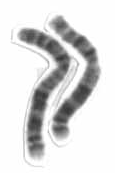| Chromosome 2 | |
|---|---|
 Human chromosome 2 pair after G banding. One is from mother, one is from father. | |
 Chromosome 2 pair in human male karyogram. | |
| Features | |
| Length (bp) | 242,696,752 bp (CHM13) |
| No. of genes | 1,194 (CCDS) [1] |
| Type | Autosome |
| Centromere position | Submetacentric [2] (93.9 Mbp [3] ) |
| Complete gene lists | |
| CCDS | Gene list |
| HGNC | Gene list |
| UniProt | Gene list |
| NCBI | Gene list |
| External map viewers | |
| Ensembl | Chromosome 2 |
| Entrez | Chromosome 2 |
| NCBI | Chromosome 2 |
| UCSC | Chromosome 2 |
| Full DNA sequences | |
| RefSeq | NC_000002 (FASTA) |
| GenBank | CM000664 (FASTA) |

Chromosome 2 is one of the twenty-three pairs of chromosomes in humans. People normally have two copies of this chromosome. Chromosome 2 is the second-largest human chromosome, spanning more than 242 million base pairs [4] and representing almost eight percent of the total DNA in human cells.

